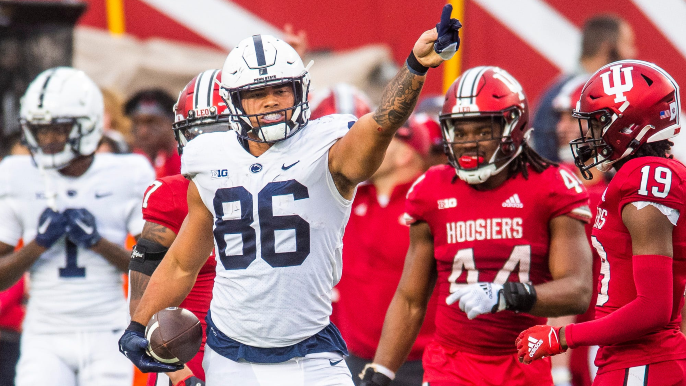
The 49ers’ Super Bowl dreams died with 7:03 left in the first quarter of the NFC Championship. What stood out immediately when watching the replay of Haason Reddick’s UCL-tearing sack-fumble on Brock Purdy, was who was blocking him: Tyler Kroft.
Discourse on a subject like that is rarely filled with nuance. Kyle Shanahan and others argued that it’s necessary, as part of the 49ers’ scheme, to block edge rushers with backup tight ends. It’s fairly common and sets up other, likely explosive plays like San Francisco’s staple, “Leak.”
The other side of the argument is that Haason Reddick is the Eagles’ best pass rusher and a replacement-level tight end like Kroft should not be blocking him.
That San Francisco had Kroft — who conspicuously remains a free agent — on that assignment was as much an indictment of Ross Dwelley and Charlie Woerner.
Outside of an attempt for a Jordan Reed-George Kittle pairing in 2020 that was doomed from the start, the 49ers have had no capable tight ends next to Kittle.
They let MyCole Pruitt go before the 2021 season in favor of Dwelley and Woerner, who despite having just 14 catches for 143 yards and 3 TDs — and mainly being a blocking tight end — out-produced both of their production combined.
The point is the 49ers have done a terrible job of getting capable tight end depth behind Kittle, despite how brightly he talks about his tight end partners, and despite the insane line a few years ago that Dwelley was one of the best players on the team.
No, really. In 2019 Kyle Shanahan said Dwelley, who had 15 catches for 91 yards and a pair of TDs — and is an objectively bad blocker — was “as good of a football player as we’ve got going right now.”
Those delusions have come to pass. They need to draft a tight end, and have reportedly scouted the position extensively.
This is viewed as a very deep tight end group, though it’s always extremely difficult to figure out how mock drafts line up with reality. There is a lot out of the 49ers hands with their first pick at 99 overall. But once they get there, it’s three out of the final four picks to end the third round.
Below are five players that could be available for San Francisco and would make sense in their offense. As a general rule, it makes sense to bet on athleticism. Almost everyone here has athletic upside:
Brenton Strange, Penn State
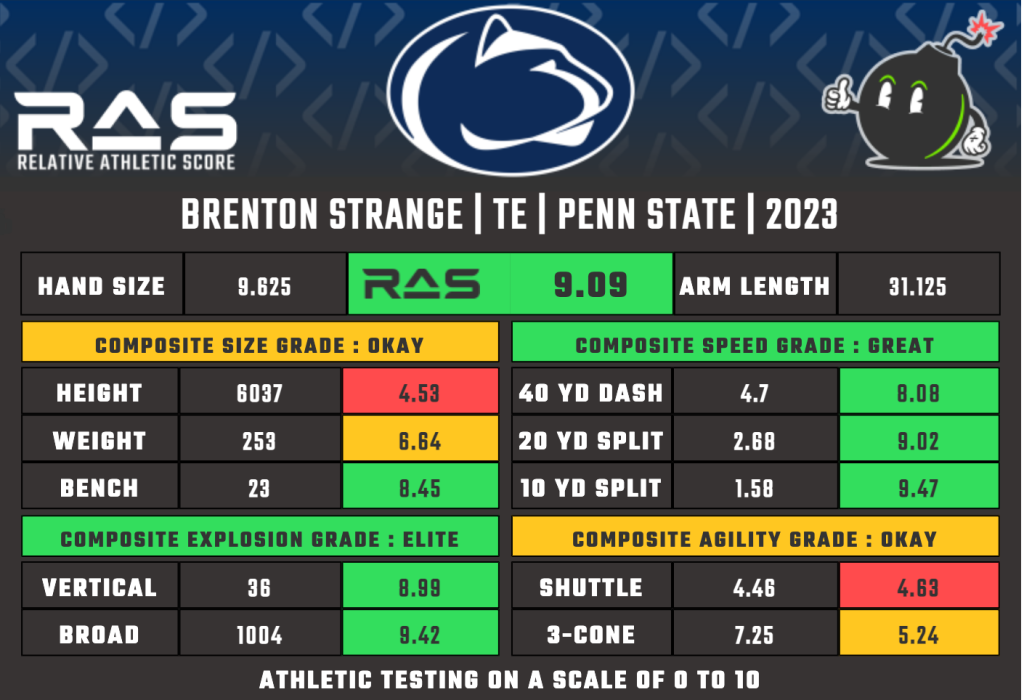
(All relative athletic score cards come courtesy of Kent Lee Platt at ras.football. Check it out here.)
Strange is generally projected as a third-round pick. The only way that makes sense is because it’s a deep tight end draft with a few guys with better college production and a bit better size. That said, I’m dubious he makes it to No. 99.
He is truly well-rounded. His athleticism jumps off the tape. He’s got NFL-caliber speed and strength, and loves to be physical with defenders.
That’s the most encouraging thing about his tape. He’s proactive as a blocker. A lot of tight end prospects will let defenders get into their chest and not look excited about initiating contact.
Strange, without question, loves to get after it, and his positioning is generally solid. With impressive play strength and the speed to get out on the edge, he’s a great match for the 49ers’ outside zone blocking schemes. He also demonstrates a rare, innate intelligence for how to cut down angles, especially when sifting or blocking on the backside.
Sometimes he’s a little too aggressive in trying to initiate, and can taken advantage of by putting himself on the back foot. But he also shows a capacity to adjust and drive his feet even if he’s not in great position. His blocking tape is far more encouraging than discouraging.
As a receiver, his movement is fluid. While his production was limited, peaking as a senior with 32 catches for 365 yards and 5 TDs, there’s not too much that suggests he can’t be a capable receiver at the next level.
He also shared time with 6-foot-6-inch tall redshirt sophomore tight end Theo Johnson, who Penn State seemed to like more — at least at times — as an outside receiving target. They had very similar production last season.
But George Kittle also had limited production at Iowa as a receiver. All the 49ers really saw was a great blocker with athletic upside. Strange, though not as large or quite as athletic, is a bit similar.
There’s more than enough to select him if he’s available. He’s the top tight end option projected to be in 49ers’ range, if he is indeed there.
Josh Whyle, Cincinnati
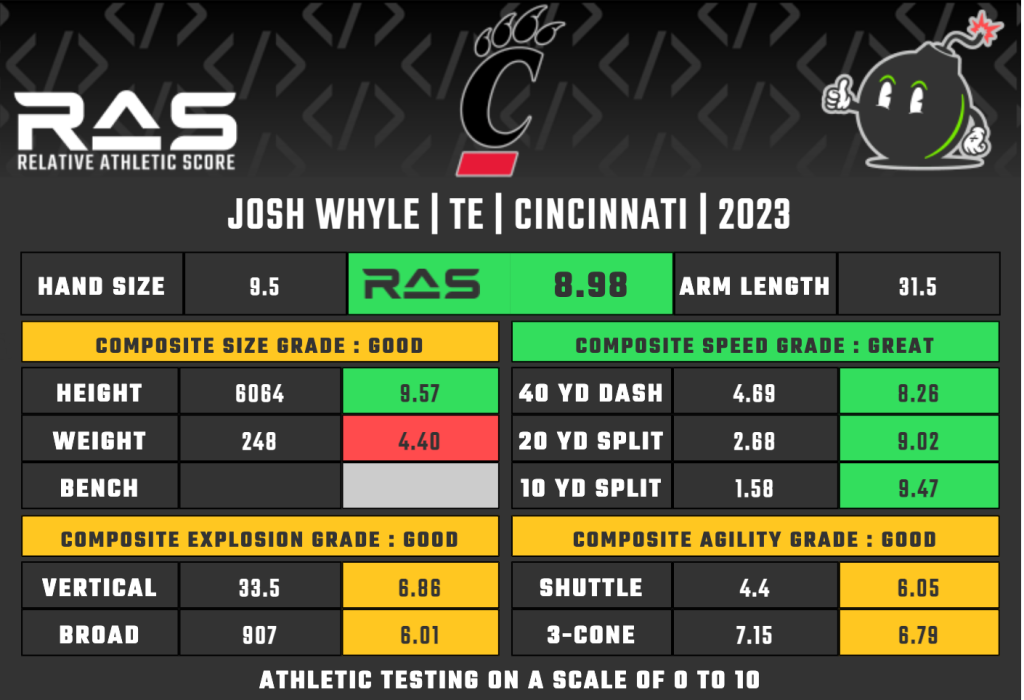
This kid can move.
The primary concern with him is that he’s a little longer than you’d like. He’s tall with a relatively thin frame which could make leverage an issue.
But he was often used in an H-back role at Cincinnati and looked like a natural making Kyle Juszczyk-like blocks through B and C gaps and getting to the second level. He displayed a fairly impressive understanding of angles and was proactive as a blocker.
Because he has that upright frame with long arms and likes to initiate contact, he puts himself at risk of being ripped off blocks by stronger defenders. Adding weight and tightening up his posture will be important for him.
Despite that, he likes to block. You can teach players who want to learn. You can’t teach players who have no interest in getting their hands dirty.
And as far as receiving upside, there’s plenty. His height could be a major red zone asset and take attention off Kittle. While he wasn’t a primary option at Cincinnati, he was involved regularly, and consistently over his last three seasons. He had 26 or more receptions and 326 or more receiving yards in each of the last three seasons with 6 TDs in each of his sophomore and junior years, and 3 TDs his senior year.
His route running needs refinement, too, but his movement is apparent, and he’s got impressive hands. As a projected fifth-round pick, he’d be a very intriguing add.
Luke Schoonmaker, Michigan
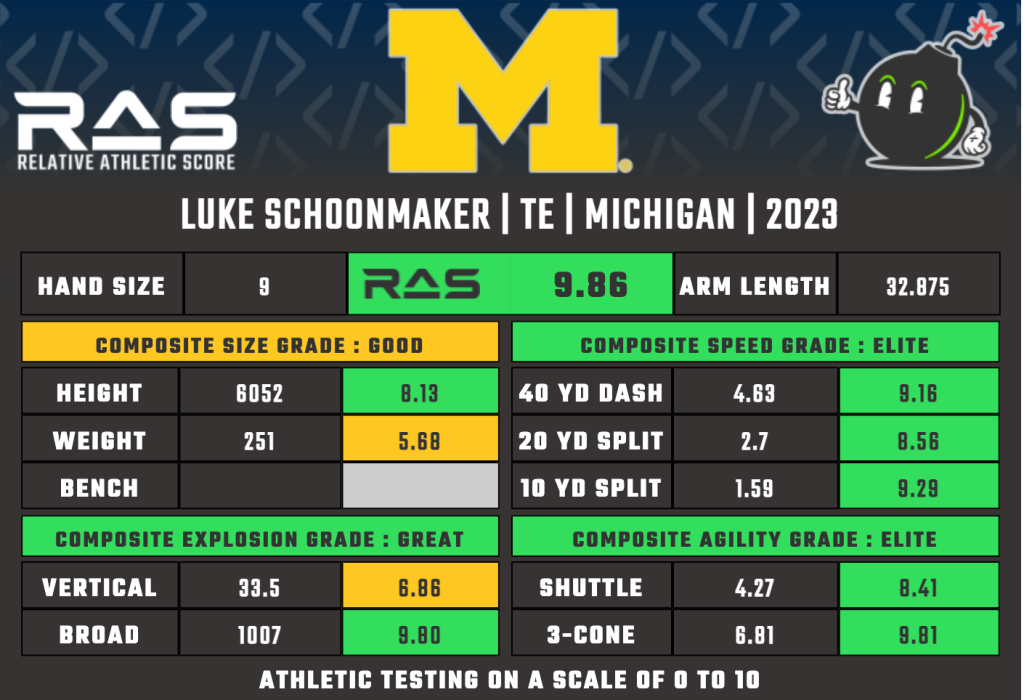
Schoonmaker is a pretty boring watch. That probably sounds pretty harsh.
It’s more a reflection of the fact that he doesn’t have any traits that wow you, but he’s good at just about everything. He has the ideal frame, solid play strength, athleticism for running after the catch and a decent foundation for his route running.
His footwork is a little clunky and heavy, and he gets a bit too upright as a blocker, rarely driving his assignment back.
At the same time, when you watch him and then think about him versus Woerner or Dwelley, he looks like an immediate, major upgrade.
A lot of his issues seem technical, and therefore — at least in theory — correctable. Something feels wrong about taking a prospect who doesn’t get you all that excited, but in late round three, taking a guy with an NFL frame and athleticism from a major program feels like a fairly safe bet.
Blake Whiteheart, Wake Forest
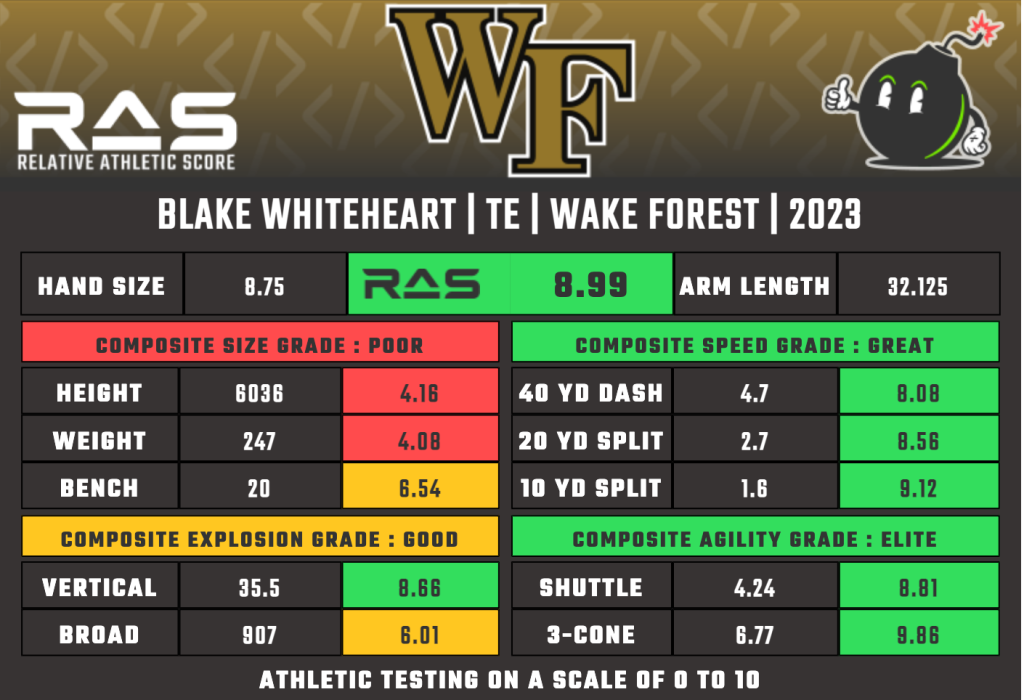
This is one of my favorites in this group. His size is underwhelming, but not damning. He’s viewed as a late-round pick because of that size, a lack of production (peaking with 24 catches, 293 yards and 3 TDs his senior season) and some other inconsistencies.
But his tape shows a lot to like. Number one, he’s committed to blocking. Number two, he’s extremely athletic and makes some impressive catches.
His blocking approach has some cause for concerns; he can get a little too grabby and over-commit. There’s at least one snap against Clemson where he allows a pressure because he steps up to initiate contact and K.J. Henry — a defensive end prospect the 49ers should also consider in the late third-round range — just counters him with a hesitation move to his inside shoulder and beats him.
The battle he and Henry had in that Wake Forest-Clemson game is very entertaining. Both have significant athletic upside and both win their fair share with a lot of ground being held on either side.
It’s Whiteheart’s attitude, though, that’s really compelling. He battles all game long against a more talented program and shows that he should probably be a bit more involved as a target in Wake Forest’s offense. Of his two catches, one was a touchdown and on the other, he knocks off a Clemson defender’s helmet, then keeps battling before the entire defense swarms to him.
He offers a lot of what you’re looking for in a fifth-round tight end prospect. His technique in all aspects can use some work, but he’s a grinder with athletic upside.
Payne Durham, Purdue
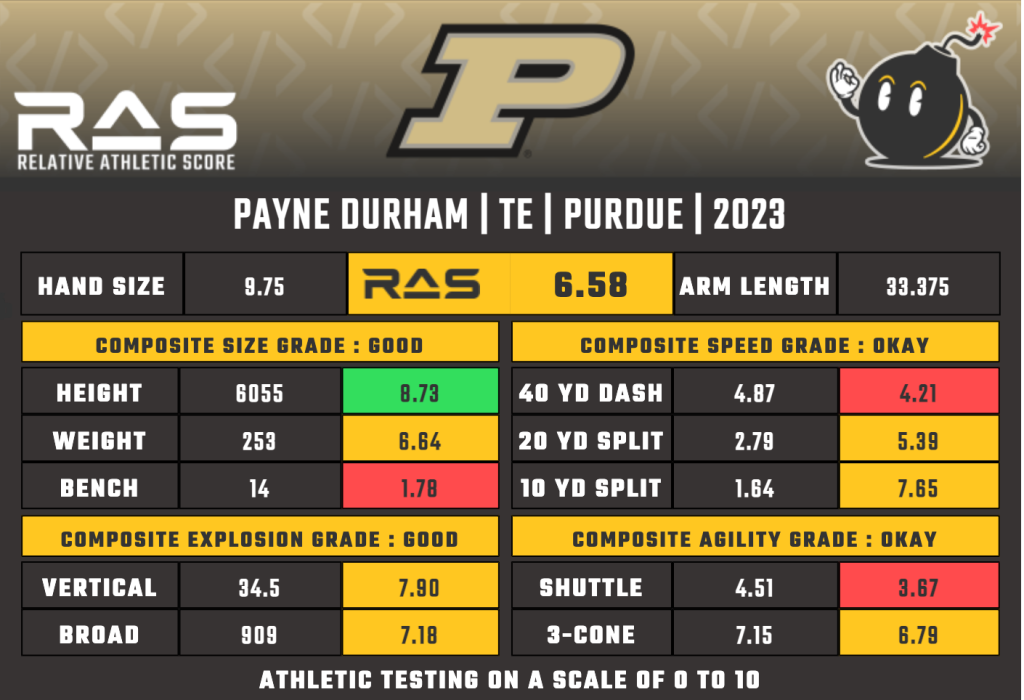
First of all, excellent tight end name.
He’s the least athletic prospect in this group, but that’s still to say he has above average athleticism.
But he’s a big boy. You can hear a “chugga chugga, chugga chugga” playing in your head when he starts running. He’s the living embodiment of the Purdue Boilermakers’ mascot; just a big dude running at you with a head of steam.
Durham is also one of the few guys here who had some substantial college production, and it grew each year. At the end of his his senior year, he finished with a stunning 56 catches (5th among TEs) for 560 yards (9th-most among TEs) and 8 TDs (T-2nd among TEs).
He’s not a guy who’s going to take the top off the defense, but he’s a solid receiver especially in the short-to-intermediate range, which is where the 49ers excel.
As a blocker, he’s got the requisite force to compete at the NFL level, but it comes with some heavy feet. He might be a better fit in a power- or gap-heavy blocking scheme, though the 49ers do run more non-zone run schemes than they’re generally given credit for.
While his feet are a little clunky, he shows a decent ability to recover, using his long arms and strength to his advantage.
He doesn’t separate from defensive backs too well, but he shows a contested catch ability and length to make up for some of that.
The concerns about him are part of the reason he’s viewed as a roughly sixth-round prospect. But he has an NFL body with decent athleticism. While his upside appears limited, he could be a plug-and-play No. 2 tight end.
Everyone else
Players who were widely projected as second or second-to-third-round prospects, like South Dakota’s Tucker Kraft and Iowa’s Sam LaPorta, were eliminated.
One thing that’s sort of tricky about scouting tight end prospects is that most of them would be upgrades for the 49ers. The bar is extremely low.
The other thing to wonder is if the 49ers would be willing to make a swing at somebody who’s not a well-rounded prospect. There are a few excellent receiving tight ends who are woeful blockers, with Old Dominion’s Zach Kuntz the most promising. He is an outrageously skilled receiver in a slim tight end build. Clemson’s Davis Allen and Miami’s Will Mallory are both similar.
But the 49ers ask a lot of their tight ends.

